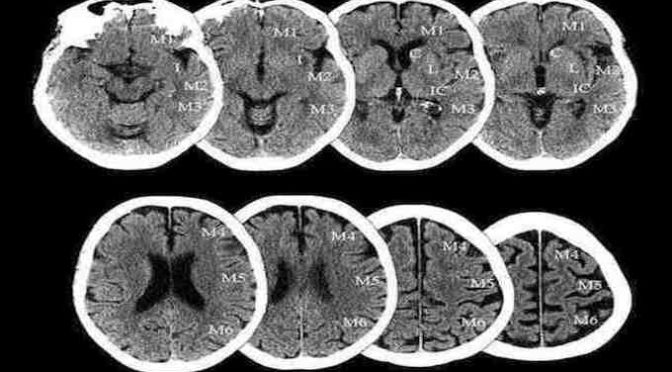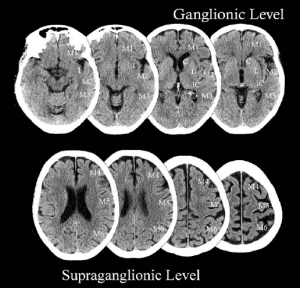CT is the radiological test of choice at emergency in stroke patients with known onset time. The ability to differentiate incipient lesions on CT emergency reaches 70%. However these injuries should be quantified.
ASPECTS scale allows a quantitative, way, give a numerical value to a qualitative assessment we value incipient signs of ischemic cerebral involvement.
It is to «assess the lack of differentiation» structures that we usually see in a TAC. We divide the cerebral hemisphere that has caused damage in 10 segments. (In these segments nuclei of gray and white matter are identified).
It is evaluated in two slices of the TAC, one just at the level of frontal horns of the lateral ventricle and the other cut in convexity of lateral ventricle. A score of 10 is that we could differentiate all structures. The score could reach 0 if we identify ten hypodense areas suggestive of infarct as already established. Seven is the cutoff, from> = 7 the patient may be a candidate for endovascular treatment or thrombolysis (equivalent to less 1/3 area of MCA infarct). Within the same segment is valued worst.
One way to differentiate structures is lower greey window to 45HU (Hounsfield units) This window can be more easy and objectively distinguish grey structures and recent infarct as hypodense areas.
ASPECT score. They are mainly two cuts which to assess the ASPECT score in basal ganglia and above in lateral ventricles but on this tour any hypodense within these territories should be penalized in the final score.
In spite of MR seems more sensitivity to find acute lesions in acute stroke but it requires so much time and patient very relaxed to perform it, this is a reason that get CT a good and reliable test in ER department to evaluate a patient with diagnosis of possible stroke.
However MRI could be a good test in posterior stroke (vertebrobasilar stroke) in acute phase to check it acute lesions. New ingenious scales and score has been mention it to evaluate ischemic lesions in vertebrobasilar portion.
Check other windows of this web www.hubstroke.com to read more about stroke.

